| Lipan Apache timeline |
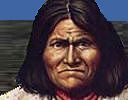 |
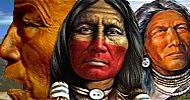 |
|
|
|
||
| N'de, Dinë, Tinde, Inde or "The People" |
| |
Chronological history timeline of the Lipan Apache tribe |
Artifact Replicas|Jewelry|Clothing|Figurines|On Sale|New ProductsLipan Apache timelineChronological history timeline of the Lipan Apache tribe. early 1500s Anthropologists say the Apache migrated South from Canada. 1600 Lipan Apaches enter Texas from Great Plains; claim area around San Antonio as homeland and call it “Many Houses;” Lipans develop a tribal identity. 1650 Lipans develop a trade route to the Pecos Pueblo by following Rio Grande upriver to the Pecos. Lipans call Pecos Pueblo “White House.” 1670 In response to severe drought, Lipan tribe splits into 2 divisions: Plains Lipans (who move into upper Colorado River region) & Forest Lipans (who return to San Antonio area). Plains Lipans acquire horses from Jumanos and pueblos of New Mexico. Forest Lipans acquire horses from pueblo of La Junta (Presidio, TX). 1674 Mission San Ildefonso de la Paz founded on Rio Escondido of Coahuila near later site of villa of Zaragosa. San Ildefonso soon abandoned. 1700 Comanches enter Texas and begin to contest the Plains Lipans for control of the high plains of Texas. 1703 Mission San Francisco Solano revived on site of older San Ildefonso mission (Coahuila). 1708 San Francisco Solano moved to the Rio Grande. 1716 Presidio San Antonio de Bexar and small church founded at San Pedro Springs (Texas) but both burn down within 2 years. May 1718 Bexar presidio moved to a site west of the San Antonio River. The Solano mission on the Rio Grande is dismantled and moved to the San Antonio River; renamed Mission San Antonio de Valero. 1715-1720 Comanches and Lipans fight epic 9-day battle in Red River Basin. Lipan corpses are “left in piles like leaves.” 1720-1725 Lipans begin sporadic raids against San Antonio; horse thefts escalate- up to ¼ of presidio’s saddle horse herd stolen at one time. Presidio troops begin retaliatory military campaigns. Nicholas Flores y Valdez follows Lipan horse thieves to Brazos River, attacks a rancheria, captures Lipan prisoners and recovers horses. 1726-1730 All quiet at San Antonio; no raids. 1730 56 Canary Island settlers arrive at San Antonio; are offered land west of presidio but deem area too exposed to Lipan raids. Settle between presidio and mission. Found villa of San Fernando de Bexar. 1730 Lipan Apaches declare war on San Antonio; attacks escalate on anyone who ventures out of villa. 1731 On Sept. 18th, over 500 Lipan warriors ambush and attack 20 Spanish troops. Just when Spaniards think the end is near, Lipans break off attack. 1745 On the night of June 30th, over 300 Lipans attack the Bexar presidio, setting fire to many buildings; when soldiers fire guns, Lipans break off and run down side streets seeking to attack from another direction; the Apache attackers are run off by a large body of mission Indians. 1749 The Lipan Apaches and Spanish at San Antonio celebrate a grand peace; Apache hostages are released and a large pit dug in Military Plaza. A live horse, war club, arrows and lance are placed in the pit and covered with dirt to signify the end of a state of warfare. 1750 Smallpox breaks out in Lipan camps along Guadalupe River. Lipans are convinced that epidemic was caused by mission clothing worn by newly-released hostages. Lipans move their camps to upper Nueces River. Lipans establish astolen horses for guns trade with east Texas tribes. 1751 A large group of Lipan traditionalists who wish no contact with Spanish other than raiding, and led by Bigotes (Whiskers or Mustached One), break away and cross the Rio Grande into Coahuila. This break-away group calls itself Kune tsa (Big Water People) and camps along Rio Escondido and Rio San Rodrigo (Coahuila). 1753 On Feb. 1st, villa of San Fernando de Austria is founded on Rio Escondido (Coahuila); first settlers come from families of San Juan Bautista 1754 First mission dedicated to converting the Lipan is founded at the site of the old mission of San Ildefonso (Rio Escondido, Coahuila) on Dec. 21st. Mission San Lorenzo lasts less than one year; during night of Oct. 4, 1755, Lipans revolt, burn mission and ride away. 1757 Second Lipan mission established on San Saba River of Texas near Menard. Mission San Saba is burned down in 1758 during an attack by Comanches and Wichitas. 1761 Third Lipan mission is founded on upper Nueces near Camp Wood, Texas- San Lorenzo de la Santa Cruz. A second small mission is founded several miles south near Montell, Texas- Nuestra Senora de la Candelaria; both missions abandoned by Lipans within 4 years. 1763 In March, Lipans attack villa of San Fernando de Austria (Coahuila), entering town by a ruse; 7 settlers killed, 40 horses stolen. 1780 Terrible smallpox epidemic ravages Lipan camps in Texas and then spreads to camps in Coahuila. So many Lipans die that priests a la Bahia fear the numerous corpses will cause other disease. Lipan shamans, seeking an herbal cure for smallpox, adopt the use of peyote from Carrizo Indians. 1760-1800 Lipan Apaches raid intensely in south Texas, Coahuila and Nuevo Leon. A series of military campaigns fail to “tame” them until 1800. 1814 Lipan Apaches fight along side rebels fighting for Mexican independence at Battle of Medina. 1827 Villa of San Fernando de Austria changes name to San Francisco de Rosas. 1836 Lipans watch Battle of Alamo unfold and want to assist Alamo defenders. Lipan proposed aid is based on friendship with Hispanic Tejano defenders, not on ties with Bowie and Travis, and dates back to Royalist-Republican battles of 1814, particularly the Battle of Medina. 1840-1880 Lipans from both sides of Rio Grande raid in Texas and drive stolen stock into Mexico to sell in border towns. 1850 Villa of San Fernando de Rosas changes name to Zaragosa (Coahuila). 1850 Zaragosa “adopts” the Lipan Apaches, offering them a settlement area at Hacienda Patino. Villa of Musquiz (Coahuila) “adopts” Kickapoo, who had crossed into Mexico 1850 Lipans and Kickapoo begin to fight each other in Coahuila. 1850 Smallpox epidemic in Texas drives many Texas Lipans into Mexico or New Mexico. 1869 Mexican troops from Monterrey brought to Zaragosa to eliminate Lipan Apaches, who are blamed for causing trouble. Troops attack many Lipan camps; survivors flee to the Mescaleros in New Mexico. 1873 US Army commander Ranald Mackenzie crosses Rio Grande with his troops and attacks Lipan camps at El Remolino (Coahuila). 1872-1875 US Army in New Mexico begins to force Mescalero Apaches and some Lipan Apaches onto a reservation in New Mexico. 1875-1876 US Army troops undertake joint military campaigns with Mexican Army to eliminate Lipans from Coahuila. 1881 Large campaign by Mexican Army’s Diaz division (assisted by US troops) runs all Lipans out of Coahuila and into Chihuahua State. 1884 A small number of Texas Lipans are transferred to a reservation in Oklahoma (Oakland Agency). 1903 About 30 Lipans are redeemed from a cattle pen in Chihuahua City, Chihuahua (where they were held as prisoners). This group is brought to New Mexico. 
Great Plains Warrior Art Print Grigg, Carol Buy at AllPosters.com Framed Mounted |
What's New in the Gallery Store: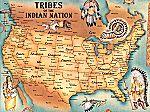 Native American Tribes by States Poster 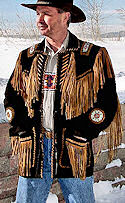 25 new fringed leather jackets 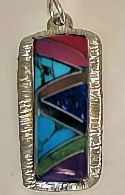 Zuni Style inlaid stone jewelry More New Products |
||||||||||||||||||||||||||||||||||||||||||||||||||||||||||||
Apache chastity and marriage Apache customs regarding courtship, marriage and divorce. Wives and burial place of Geronimo A detailed list of all the wives of Gernonimo and his burial place. Why do we yell "Geronimo"? Learn the legend behind this phrase. Apache tribal amusements, manners, and customs As explained by Geronimo in the telling of his life story.
| |
| Back to Top |Shipping & Return Policies |Customer Testimonials |Site Map |Affiliate Program |Privacy Policy |Contact Us | Submissions |